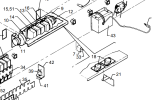maduro
Pre-takeoff checklist
- Joined
- Jun 20, 2013
- Messages
- 100
- Display Name
Display name:
Maduro
My instrument panel illumination lights never worked since I bought my arrow a year ago. I am now trying to sort it out. I've replaced all the old incandescent bulbs with red LED bulbs to no avail. None of the light bulb illuminate when I turn it on. I am now thinking the wiring is messed up. Where do I even begin to troubleshoot this issue if I can/able? Thanx.
This thread seams to touch on the subject but it's old. Wondering if there is a more updated solution.

 www.pilotsofamerica.com
www.pilotsofamerica.com
This thread seams to touch on the subject but it's old. Wondering if there is a more updated solution.
Panel lights problem
Interesting (and annoying) electrical problem. Only appears to affect the panel lights (those little GE53 bulbs). Very few of the instruments in the cherokee are self-lit. Most have the GE53 bulb at the corner of the instrument, and the plastic panel overlay has a reflective surface on the back...


